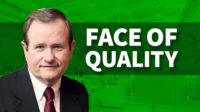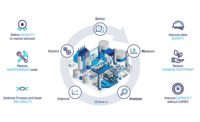In May, thousands of quality professionals from across the globe gathered in Milwaukee, WI, to attend the American Society for Quality’s 2016 World Conference on Quality and Improvement. To celebrate their 70th anniversary as an organization, ASQ held more than 100 sessions and workshops for attendees that presented real-life applications and solutions based on proven quality methods. The conference also featured several illustrious keynote speakers who highlighted the importance of knowing oneself before being able to successfully lead and inspire others.
Several of these sessions and keynotes focused on how to become a more dynamic and effective leader by using quality principles to attain optimal results. Here a few of Quality’s takeaways from those presentations.
“Start with engaging first, always.”
Dale Schattenkirk, a Lean Six Sigma Master Black Belt and the director of advisory services at KMPG Canada, addressed the “paradox of choice” in his presentation: “Understanding and Implementing Leadership Standard Work.”
“The more choices a person is given to make,” Schatternkirk said, “the greater the chance that he or she will make the wrong choice.” However, this paradox can be reduced in an organization by a leader establishing parameters for his or her employees that are relayed through direct and simplified communication.
According to Schattenkirk, the leader’s top objective should be to “tie the strategic level to the operational level of the organization.” This starts with asking questions.
“Start with engaging first, always,” Schattenkirk said, adding that “engaging the heart and mind” begins with “asking questions of the people you serve.”
When preparing to conduct a site visit, Schattenkirk emphasized the importance of leaders setting their intentions beforehand and then following through. Upon arrival at the site, Schattenkirk said that the leader should speak directly to staff regarding the projects they’re completing on the shop floor; ask and field questions from clients and customers, if applicable; and participate in a Quality Board Standard 4.0 or “QB huddle” with the quality management team, in which positive feedback, support, and thanks for hard work is given.
When discussing priorities during the QB huddle, Schattenkirk recommended engagement in The Four Conversations, from the best-selling book The Four Conversations: Daily Communication That Gets Results by Jeffrey and Laurie Ford:
- Initiative Conversations: Proposing new or future ideas in which you tell people what you want to accomplish, when you want to accomplish it, and why it matters.
- Understanding Conversations: Participating in two-way exchanges with explanations, questions, and discussion.
- Performance Conversations: Making promises with detailed action plans.
- Closure Conversations: Acknowledging facts, appreciating people, celebrating accomplishments, apologizing for mistakes, and amending broken agreements.
Schattenkirk also said that these conversations build “credibility, accountability, and good relationships” within an organization, which is essential to maintaining trust in that organization’s leadership. A unified strategic plan that is clearly and consistently communicated from the top down bolsters that trust, in addition to leaders holding each other accountable for regular site visits and QB huddles by establishing a schedule and sticking to it.
On what it takes to be a successful leader, Schatternkirk said, “You’ve got to be present. You’ve got to show up.”
“Experience builds blind spots.”
Liz Wiseman was one of the ASQ’s conference’s five keynote speakers. She is the president of The Wiseman Group, a leadership research and development firm headquartered in Silicon Valley, and the author of three best-selling books, including Rookie Smarts: Why Learning Beats Knowing in the New Game of Work.
In her presentation, Wiseman explained how leaders can continue to innovate by maintaining a “rookie” mentality.
In rookie mode, which Wiseman also called “hunter-gatherer mode,” a leader is forced to look outward—seeking expertise from others; listening to and implementing their advice—which makes for stronger and more multifaceted work.
“When we’re rookies, we’re at our most focused,” Wiseman said. “We have adrenaline and passion.”
Conversely, when a person becomes more experienced in a position, the work becomes “too easy,’” Wiseman said—and as a result, not nearly as careful, inventive, or rewarding as the work that comes out of the urgency and agility of rookie mode.
“Turns out, experience builds blind spots,” Wiseman said. “When we see patterns, our mind goes on autopilot…This is what happens when we start having all the answers.”
Wiseman proposed that leaders take the following steps to ensure that they and their longstanding employees don’t fall into ruts that preclude innovation.
- Use your rookies. If you’ve become the mentor in your workplace, reverse the roles. Ask the rookie questions that you can use to pump more energy and creativity into your work.
- Build heterogeneous teams. When forming teams to work on projects, make sure to add more rookies to certain groups and more veterans to others, and not make every group even-numbered (if it’s two-on-two with veterans and rookies, for example, the veterans will always take the lead). With more mixed groups, the veterans and the rookies can better learn from each other and incorporate ideas.
- Be perpetual rookies. If you’re feeling overworked and underutilized, Wiseman said, “disqualify yourself” from the role you’re in and go about finding a new one, or start taking on new assignments to make your work more fruitful and fulfilling.
Wiseman said that staying in rookie mode—always looking for new problems to solve, new people to reach out to, and new ways to grow—is how confident and innovative leaders are born.
“Leadership is mostly about behavior."
For the presentation entitled “Seven Powerful Lessons for Leadership in ISO 9001: 2015,” Joseph Muratore and John DiMaria of BSI Group began by discussing the difference between management and leadership.
“Management is about processes, while leadership is mostly about behavior,” DiMaria said. While management relies heavily on tangible, measurable capabilities, he added, "leadership relies on what is less tangible."
"In order to audit leadership, the questions have to start at the top," DiMaria continued. For example, what is leadership’s view of risk-based thinking? How does leadership ensure the quality management system is in line with the strategic direction of the organization? How does leadership take responsibility?
“Leaders don’t push the organization,” Muratore clarified. “They lead the organization.” Leaders establish unity of purpose and focus the direction of the organization; thus, it is leadership’s responsibility, Muratore said, to “drive habits of excellence within the organization.”
DiMaria agreed, saying that “it’s leadership’s responsibility to change behavior," meaning“there are no bad teams, only bad leaders.”
Muratore and DiMaria’s presentation also highlighted the three major building blocks of a resilient organization: strategic adaptability, agile leadership, and robust governance. In addition, they pointed out that organizational resilience is built on three main elements: product excellence, process reliability, and people’s behavior.
In regard to leadership lessons that can be gleaned from ISO 9001: 2015, Muratore and DiMaria enumerated the following:
- Lesson #1: Responsibility – Organizational reliance is largely dependent on leadership instilling a culture that transcends the usual operational silos.
- Lesson #2: Policy – Alignment of business concerns is crucial to establishing operational harmony.
- Lesson #3: Objectives – Leadership weaves the core principle of quality throughout the organizations, across departments and functions, so that employees can become more engaged and take ownerships of the organization’s strategic aims.
- Lesson #4: Integration – The 2015 revision requires the process approach to be integrated into the organization’s functionality, which will help the organization in exposing risks as well as opportunities.
- Lesson #5: Compliance – Leadership must demonstrate the organization’s commitment to the customer’s need. Statutory, regulatory, and contractural requirements must be maintained.
- Lesson #6: Operational Awareness – Risk plays a bigger role in the new standard. Therefore, leadership must be cognizant of opportunities that could improve quality, and, conversely, be aware of risks and their potential impact on the quality of the product or service.
- Lesson #7: Authorities – Only the leadership of top management has the authority to ensure operational implementation and execution.
In conclusion, Muratore and DiMaria summed up the series of changes that ISO 9001: 2015 requires, which they also said are leadership’s responsibility to carry out:
- Implementing a process approach.
- Encouraging risk-based thinking.
- Confirming the context of the
- organization.
- Moving leadership away from a single management contact.
- Bridging silos.
- Establishing a holistic approach to quality.
“Your employees are your best resource,” DiMaria said. This statement cements the idea also accentuated by other presenters at the conference: that the best leaders are the ones who actively listen and learn.




